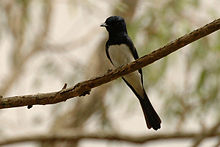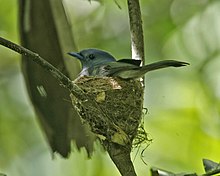| Revision as of 12:20, 24 February 2011 editArthurBot (talk | contribs)259,345 editsm r2.6.3) (robot Adding: cs:Lejskovcovití← Previous edit | Revision as of 13:37, 25 April 2011 edit undoDawynn (talk | contribs)Extended confirmed users, Pending changes reviewers259,894 editsNo edit summaryNext edit → | ||
| Line 148: | Line 148: | ||
| {{DEFAULTSORT:Monarch Flycatcher}} | {{DEFAULTSORT:Monarch Flycatcher}} | ||
| ] | ] | ||
| ] | ] | ||
Revision as of 13:37, 25 April 2011
| Monarchidae | |
|---|---|

| |
| Mascarene Paradise-flycatcher Terpsiphone bourbonnensis | |
| Scientific classification | |
| Kingdom: | Animalia |
| Phylum: | Chordata |
| Class: | Aves |
| Order: | Passeriformes |
| Suborder: | Passeri |
| Family: | Monarchidae Bonaparte, 1854 |
| Genera | |
|
See text | |
The Monarch Flycatchers (Monarchidae) comprise a family of passerine birds which includes boatbills, shrikebills, paradise-flycatchers, and magpie-larks.
Monarchids are small insectivorous songbirds with long tails. They inhabit forest or woodland across sub-Saharan Africa, south-east Asia, Australasia and a number of Pacific islands. Only a few species migrate. Many species decorate their cup-shaped nests with lichen.
Morphology and description
The monarch flycatchers are a diverse family of passerine birds that are generally arboreal (with the exception of the magpie-larks). They are mostly slim birds and possess broad bills. The bills of some species are quite large; the boatbills of the genus Machaerirhynchus are very broad and flat, and the heavy-set bills of the shrikebills are used to probe dead wood and leaves. The plumage of the family ranges from sombre, like the almost monochrome Black Monarch, to spectacular, like the Golden Monarch. The tails are generally long and spectacularly so in the paradise-flycatchers in the genus Terpsiphone. Sexual dimorphism in plumage can be subtle, as in the Paperbark Flycatcher, where the female is identical to the male except for a slight buff on the throat; striking, as in the Chuuk Monarch where the male almost entirely white and the female entirely black; or non-existent, as in the Tahiti Monarch. In some species, for example the Madagascar Paradise-flycatcher, the males have two or more colour morphs.
Distribution, habitat and movements

The monarch flycatchers have a mostly Old World distribution. In the western end of their range they are distributed through sub-Saharan Africa, Madagascar and the islands of the tropical Indian Ocean. They also occur in South and Southeastern Asia, north to Japan, down to New Guinea and most of Australia. The family has managed to reach many Pacific islands, and several endemic genera occur across Micronesia, Melanesia and Polynesia as far as Hawaii and the Marquesas.
The paradise-flycatchers of the genus Terpsiphone has the widest distribution of any of the monarch flycatchers, ranging almost all of sub-Saharan Africa, Madagascar, the Mascarenes and Seychelles, South, East and Southeastern Asia as far as Korea, Afghanistan, the Philippines and the Lesser Sundas. The other paradise-flycatcher genus, Trochocercus is restricted to Africa. The other exclusively Asian genus is the Hypothymis monarchs. The remaining genera are predominately found in the Austro-Papuan and Oceania regions. A few monotypic genera are restricted to Pacific island; these include the Silktail (Lamprolia) in Fiji, the Chuuk Monarch (Metabolus) in the Micronesian island of Chuuk, the Hawaiian Elepaio (Chasiempis) and the Buff-bellied Monarch (Neolalage) which is restricted to the islands of Vanuatu. Other Pacific genera are the shrikebills (Clytorhynchus), the Mayrornis monarchs, both of which are found in Melanesia and west Polynesia, and the Pomarea monarchs which are exclusively Polynesian in origin.
The majority of the family is found in forest and woodland habitats. Species that live in more open woodlands tend to live in the higher levels of the trees but, in denser forest, live in the middle and lower levels. Other habitats used by monarch flycatchers include savannah and mangroves, and the terrestrial Magpie-lark occurs in most Australian habitats except the driest deserts.
While the majority of monarch-flycatchers are resident, a few species are partially migratory and one, the Satin Flycatcher, is fully migratory, although the Japanese Paradise-flycatcher is almost entirely migratory. The Asian Paradise-flycatcher is migratory over the northern parts of its range and sedentary in the tropics, and the African Paradise-flycatcher makes a series of poorly understood intra-African migratory movements.
Breeding

The monarch-flycatchers are generally monogamous, with the pair bonds ranging from just a single season (as in the African Paradise-flycatcher) to life (the Elepaio). Only three species are known to engage in cooperative breeding; but many species are as yet unstudied. They are generally territorial, defending territories that are around 2 ha in size, but a few species may cluster their nesting sites closely together. Nesting sites may also be chosen close to aggressive species, for example Leaden Flycatchers nests may be located near the nests of the aggressive Noisy Friarbird. The nests are in turn often aggressively defended by monarch flycatchers. In all species the nest is an open cup on a branch, fork or twig. In some species the nests can be highly conspicuous.
Systematics
Many of the approximately 140 species making up the family were previously assigned to other groups, largely on the basis of general morphology or behaviour. The Magpie-lark, for example, was assigned to the same family as the White-winged Chough, since both build unusual nests from mud rather than vegetable matter. The Australasian fantails were thought to be allied with the fantails of the northern hemisphere (they have a similar diet and behaviour), and so on.
With the new insights generated by the DNA-DNA hybridisation studies of Sibley and his co-workers toward the end of the 20th century, however, it became clear that these apparently unrelated birds were all descended from a common ancestor: the same crow-like ancestor that gave rise to the drongos. On that basis they have been included as a subfamily of the Dicruridae, along with the fantails, although Christidis and Boles have more recently treated it at familial rank as Monarchidae.
More recently, the grouping has been refined somewhat as the original concept of Corvida has proven paraphyletic. The narrower 'Core corvine' group now comprises the crows and ravens, shrikes, birds of paradise, fantails, monarch flycatchers, drongos and mudnest builders.
The Monarchs are small to medium-sized insectivorous passerines, many of which hunt by flycatching.
Taxonomic list of Monarchidae
Based on del Hoyo et al. (2006)
- Genus Hypothymis (4 species)
- Genus Eutrichomyias – Cerulean Paradise-flycatcher
- Genus Trochocercus
- Blue-headed Crested Flycatcher, Trochocercus nitens
- African Crested Flycatcher, Trochocercus cyanomelas

- Genus Terpsiphone – typical paradise-flycatchers (14 species)
- Genus Chasiempis – ʻElepaio
- Genus Pomarea
- Eiao Monarch, Pomarea fluxa – extinct (late 1970s). Formerly included in P. mendozae
- Nuku Hiva Monarch, Pomarea nukuhivae – extinct (20th century). Formerly included in P. iphis
- Rarotonga Monarch, Pomarea dimidiata
- Tahiti Monarch,Pomarea nigra
- Marquesas Monarch, Pomarea mendozae
- Hiva Oa Monarch, Pomarea mendozae mendozae – extinct (late 1970s)
- Ua Pou Monarch, Pomarea mira – extinct (c. 1986). Formerly included in P. mendozae
- Maupiti Monarch, Pomarea pomarea – extinct (mid-19th century)
- Iphis Monarch, Pomarea iphis
- Fatuhiva Monarch, Pomarea whitneyi
- Genus Mayrornis (3 species)
- Genus Neolalage (1 species)
- Genus Clytorhynchus, Shrikebills (5 species)
- Genus Metabolus (1 species)
- Genus Monarcha

Black-faced Monarch, Monarcha melanopsis - Black Monarch, Monarcha axillaris
- Rufous Monarch, Monarcha rubiensis
- Island Monarch, Monarcha cinerascens
- Black-faced Monarch, Monarcha melanopsis
- Black-winged Monarch, Monarcha frater
- Bougainville Monarch, Monarcha erythrostictus
- Chestnut-bellied Monarch, Monarcha castaneiventris
- White-capped Monarch, Monarcha richardsii
- White-eared Monarch, Monarcha leucotis
- White-naped Monarch, Monarcha pileatus
- Loetoe Monarch, Monarcha castus
- Spot-winged Monarch, Monarcha guttulus
- Black-bibbed Monarch, Monarcha mundus
- Flores Monarch, Monarcha sacerdotum
- Black-chinned Monarch, Monarcha boanensis
- Spectacled Monarch, Monarcha trivirgatus
- White-tailed Monarch, Monarcha leucurus
- White-tipped Monarch, Monarcha everetti
- Black-tipped Monarch, Monarcha loricatus
- Black-backed Monarch, Monarcha julianae
- Biak Monarch, Monarcha brehmii
- Hooded Monarch, Monarcha manadensis
- Manus Monarch, Monarcha infelix
- White-breasted Monarch, Monarcha menckei
- Black-tailed Monarch, Monarcha verticalis
- Black-and-white Monarch, Monarcha barbatus
- Kulambangra Monarch, Monarcha browni
- White-collared Monarch, Monarcha viduus
- Yap Monarch, Monarcha godeffroyi
- Tinian Monarch, Monarcha takatsukasae
- Golden Monarch, Monarcha chrysomela
- Genus Arses (4 species)
- Genus Myiagra
- Guam Flycatcher, Myiagra freycineti – extinct (1983)
- Oceanic Flycatcher, Myiagra oceanica
- Palau Flycatcher, Myiagra erythrops
- Pohnpei Flycatcher, Myiagra pluto
- Moluccan Flycatcher, Myiagra galeata
- Biak Flycatcher, Myiagra atra
- Leaden Flycatcher, Myiagra rubecula
- Steel-blue Flycatcher, Myiagra ferrocyanea

- Ochre-headed Flycatcher, Myiagra cervinicauda
- Melanesian Flycatcher, Myiagra caledonica
- Vanikoro Flycatcher, Myiagra vanikorensis
- Samoan Flycatcher, Myiagra albiventris
- Blue-crested Flycatcher, Myiagra azureocapilla
- Broad-billed Flycatcher, Myiagra ruficollis
- Satin Flycatcher, Myiagra cyanoleuca
- Shining Flycatcher, Myiagra alecto
- Dull Flycatcher, Myiagra hebetior
- Paperbark Flycatcher, Myiagra nana
- Restless Flycatcher, Myiagra inquieta
- Genus Lamprolia – Silktail (Taxonomic position uncertain)
- Genus Machaerirhynchus – boatbills (2 species – Taxonomic position uncertain)
- Genus Elminia
- African Blue Flycatcher, Elminia longicauda
- White-tailed Blue Flycatcher, Elminia albicauda
- Dusky Crested Flycatcher, Elminia nigromitrata
- White-bellied Crested Flycatcher, Elminia albiventris
- White-tailed Crested Flycatcher, Elminia albonotata
- Genus Erythrocercus – probably belongs to the Cettiidae
- Yellow Flycatcher, Erythrocercus holochlorus
- Chestnut-capped Flycatcher, Erythrocercus mccallii
- Livingstone's Flycatcher, Erythrocercus livingstonei
- Genus Grallina Magpie-larks (2 species)
References
- Garnett, Stephen (1991). Forshaw, Joseph (ed.). Encyclopaedia of Animals: Birds. London: Merehurst Press. pp. 200–201. ISBN 1-85391-186-0.
- Duston, Guy (2006). "The Pacific shrikebills (Clytorhynchus) and the case for species status for the form sanctaecrucis". Bulletin of the British Ornithological Club. 126 (4): 299–308.
{{cite journal}}:|format=requires|url=(help); Cite has empty unknown parameter:|coauthors=(help); External link in|title= - Mulder, Raoul (2003). "Ontogeny of male plumage dichromatism in Madagascar paradise flycatchers Terpsiphone mutata". Journal of Avian Biology. 33 (4): 342–348. doi:10.1034/j.1600-048X.2002.02888.x.
{{cite journal}}: Unknown parameter|coauthors=ignored (|author=suggested) (help) - Marchant, S (1983). "Suggested nesting association between Leaden Flycatchers and Noisy Friarbirds". Emu. 83 (2): 119–122. doi:10.1071/MU9830119.
- Sibley, Charles Gald & Ahlquist, Jon Edward (1990): Phylogeny and classification of birds. Yale University Press, New Haven, Conn.
- Christidis L, Boles WE (1994). The Taxonomy and Species of Birds of Australia and its Territories. Melbourne: RAOU.
- Christidis L, Boles WE (2008). Systematics and Taxonomy of Australian Birds. Canberra: CSIRO Publishing. p. 174. ISBN 9780643065116.
- Cracraft J, Barker FK, Braun M, Harshman J, Dyke GJ, Feinstein J, Stanley S, Cibois A, Schikler P, Beresford P, García-Moreno J, Sorenson MD, Yuri T, Mindell DP (2004). "Phylogenetic relationships among modern birds (Neornithes): toward an avian tree of life". In Cracraft J, Donoghue MJ (ed.). Assembling the tree of life. New York: Oxford Univ. Press. pp. 468–89. ISBN 0195172345.
{{cite book}}: CS1 maint: multiple names: authors list (link)
- Del Hoyo, J.; Elliot, A. & Christie D. (editors). (2006). Handbook of the Birds of the World. Volume 11: Old World Flycatchers to Old World Warblers. Lynx Edicions. ISBN 849655306X.
External links
- Monarch Flycatcher videos on the Internet Bird Collection